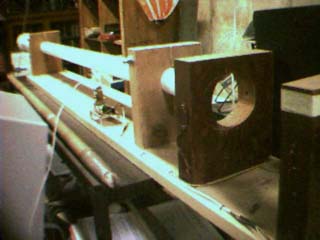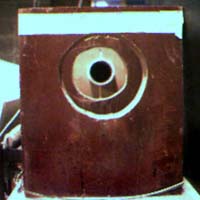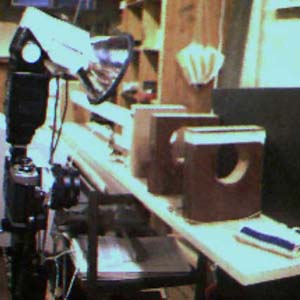 A potato cannon is a simple device made of readily available materials and capable of propelling objects with high speed. Most often these cannons are made from commercial PVC plumbing stock. It is extremely important to use "Schedule 40" type components as their walls are thicker and they are designed to withstand higher pressures. My cannon is shown in the figure to the left restrained in its working cradle. Its muzzle is 43 mm ID, 49 mm OD, and 1.2 m long. All dimensions are approximate. The muzzle end has been beveled to serve as a cutting edge for loading vegetables. The muzzle is held in place by two clamps each made from a pine two-by-six and a carrage bolt with a wing nut. The cradle is a select piece of one-by-eight long enough to hold the cannon, timing stations, and the experimental area.
A potato cannon is a simple device made of readily available materials and capable of propelling objects with high speed. Most often these cannons are made from commercial PVC plumbing stock. It is extremely important to use "Schedule 40" type components as their walls are thicker and they are designed to withstand higher pressures. My cannon is shown in the figure to the left restrained in its working cradle. Its muzzle is 43 mm ID, 49 mm OD, and 1.2 m long. All dimensions are approximate. The muzzle end has been beveled to serve as a cutting edge for loading vegetables. The muzzle is held in place by two clamps each made from a pine two-by-six and a carrage bolt with a wing nut. The cradle is a select piece of one-by-eight long enough to hold the cannon, timing stations, and the experimental area.
The breech end is made of a larger diameter piece of (Schedule 40) PVC tubing with a tapered adaptor on one end to mate with the muzzle and an inside screw cap on the opposite end. Its dimensions are roughly 75 mm ID, 87 mm OD, and 0.4 m long.  A Coleman lamp flint-type ignitor is inserted through a hole drilled in the screw cap and used to fire the cannon.
A Coleman lamp flint-type ignitor is inserted through a hole drilled in the screw cap and used to fire the cannon.
These cannons are typically fueled using a can of hairspray. Certain formulations contain "SD Alcohol 40" as the first ingredient and some hydrocarbon like butane as second. The alcohol serves as a decent fuel but it's the other, lower concentration components that are a nuisance for long term use. The fragrances used can become overpowering in anything but wide-open space and the structural adhesives and building agents really gum up the cannon's insides pretty quickly. For these reasons I fuel my cannon with a hand spray bottle of denatured ethanol, available at a local hardware store. Its odor is relatively light and benign and it can actually keep the cannon clean. The only problem with it is that a cannon fueled with it doesn't fire well when the ambient temperature drops below around 70°F (20°C). I have found that adding acetone, also available from hardware stores, to a 10-20% (v/v) level takes care of this nicely. Unfortunately, the acetone attacks most spray bottles and evaporates quickly so the mixture doesn't store well.
The target's eye view of the muzzle is shown in the figure to the right. The relative orientation of the timing stations can be seen in this figure.
The target area can be seen in the figure to the left. A large sheet of heavy black paper provides a nice background for the photographs. A 35 mm SLR camera with a standard 50 mm lens is mounted on an adjustable tripod on the left.  A commercial flash unit mounts on top of the camera but is used only as mount for the home-made strobe which can be seen above it. Masking tape proves adequate for attachment and is easily removed for reconfiguration. A small sock, rolled up into a tube, rests on the cradle ready to be inserted into the muzzle and positioned with a long wooden pole shown just to the left of the cradle.
A commercial flash unit mounts on top of the camera but is used only as mount for the home-made strobe which can be seen above it. Masking tape proves adequate for attachment and is easily removed for reconfiguration. A small sock, rolled up into a tube, rests on the cradle ready to be inserted into the muzzle and positioned with a long wooden pole shown just to the left of the cradle.
